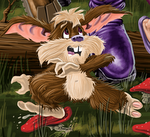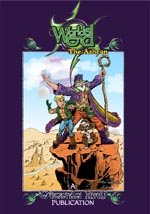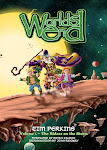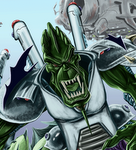 Hi Guys,
Hi Guys,Today I am going to continue to look at the major changes between the sixties and the present day with the shift in content, approaches in storytelling and the breaking down of the old vision of the hero.
The need for a new look and inventive way to attract new readers to a dying industry in the US gave the creative inventiveness of Jack Kirby and Stan Lee, followed by others like Steve Ditko, and the rest of the Merry Marvel Bullpen the opportunity to try anything and everything in an attempt to stop the doors finally closing on the comics publishing enterprise that was Timely then Marvel Comics.
So it was that a new direction was created, which was to form the basis of comics in the US for the next twenty, or thirty years, or so.
Here in the UK, quite the opposite was happening as we continued to see comics printed in photogravure, using fully painted art techniques to realise the stories, alongside the more common black and white/ dual colour comics, being produced in plenty at the time.
So it was that on both sides of the Atlantic children were being given lots of variety, of content, genre and styles of execution.
The creative forces on both sides of the Pond looked to each other for inspiration and there are some obvious nods of the head to both from both too. Nothing seemed to be unapproachable, as far as the content seemed concerned. Every genre, here in the UK was being utilised and given to the children. In the USA, however the predominant genre of the period was and, as a result, still is the Superheroes story.
The main adjective to use to describe the content of the comics back then would be FUN! That is something I would like you to bear in mind for future reference in this series of Blogs.
Back in the sixties the stories at Marvel, the USA’s main comic company nowadays, but back then a struggling number two, at best, had Stan Lee (writer/editor in chief) and Jack Kirby (artist/writer/storyteller) as the main driving force.
There was a cross-over period from the late fifties when Marvel were producing “B” Movie Monster stories alongside Cowboys and Jack Kirby was the key artist on these. Sales on even these titles were waning as the comic buyer became disenchanted with the genres. It was during the early sixties when Stan Lee was given the okay to start a new last ditch effort comic to see if it was as successful as the Justice League of America was over at their competitors DC, then National Publications. He called Jack in to try and come up with something to help them keep their jobs…that title was the Fantastic Four.
The stories ranged from the normal (if you can call super-heroics normal) to the cosmic, mainly due to Kirby’s love of the concept of gods and the wonderful pantheons from within various mythologies throughout man’s history.
Over here in the UK we still had the Eagle comic, although many cite this period as the beginning of the downfall of the once-great UK comic following the take over by Odhams Press. Alongside it were countless black and white, or dual colour humour comics and adventure comics and full colour ones too, like TV 21 and Lady Penelope, both licensed from the Gerry Anderson TV puppet series.
The artwork on both sides of the Atlantic was both dynamic and full of edge of your seats stuff, at least as far as Marvel were concerned and pretty soon DC comics found themselves having to compete with all that. In the States the development of the working relationship of the art team began with teams of pencillers, working with teams of inkers, colourists and letterers with Stan Lee at the helm writing the dialogue and the captions from the artwork provided by the artists. These stories were sometimes plotted between Lee and the penciller over the phone, or during a visit to the Marvel offices, or else the penciller would just provide the artwork with dialogue and comments in the gutters, for Lee to interpret it and “rewrite” it, something often disputed by both parties.
Here in the UK artists such as Don Lawrence, Ronald Embleton and the like were producing mini cinemascope epics in full colour on a regular weekly basis. Their fully painted vistas were spectacles every bit as exciting, dynamic and colourful, as any big screen production at the cinema. The paper was becoming glossier here, emulating the imported US comics’ covers.
When Stan Lee began working with the artists at Marvel there was a new approach adopted with the stories. Whereas DC and the other US publishers tended towards the fantasy “what if” storylines, Marvel adopted a more realistic approach with illness striking at heroes like Spiderman with his colds and arguments between loved ones, as in the Fantastic Four and X-Men.
In the UK the stories remained more about the big picture rather than lots of characterisation, although each character was usually written in such a way as to be distinguishable from the rest.
The one thing both sides of the pond agreed on was that there was an absolute distinction between hero and villain. There was no blurring of the two…the good guy was the hero and the bad guy was the villain…always.
The stories were nearly always self-contained in the US, with only the occasional two-parter, which may take place over two comics if say the Hulk and Fantastic Four were involved. So the first part of the story may take place in Hulk and the second part in the Fantastic Four, or vice versa.
In the UK most stories were again self-contained and shorter in length, compared to the larger page count of their American counterparts, but some did have cliffhanger endings to be continued the following week.
As the comics in the USA were finding themselves being reinvented due to the impact Marvel’s “New look and approach” was having on the, market the content was shifting and searching for a new identity and was all completely new with anything goes types of stories, as it had no previous continuity before it.
As the new look comics found themselves on the newsstand, the fans insatiable appetite for more and more of the same grew and as it did, so did the number of readers, but a change was taking place within the readership too, as kids got older, but continued to read them in larger numbers than before and sales grew as a consequence.
Stan Lee was often seen on College Campuses up and down the USA giving talks and interviews with the students and later on TV, as the readership became something other than just kids.
Here in the UK the same was true, but without a Lee figure to guide that growth the public still looked on the comics (a visual feast – at times worthy of inclusion in any illustrated book for adults) as the domain of children.
In the USA fan clubs sprouted up, up and down the land and conventions took place with guest writers and artists furthering the work of Stan Lee and his college visits.
Here in the UK there was a much slower start to the age of the convention, but smaller events did start to appear.
Another phenomenon was in the process of being created too, the Geek element began to show itself, both in the US and UK. That collector, whose collection and knowledge of everything comics is obsessive to say the least. Spotted a mile off at conventions the Geek is usually clad in a jacket, regardless of the weather, sports a rucksack, for carrying his supplies of comics, has long hair, glasses and roughly hewed beard, regardless of fashion, smells rather rancid, has never had a girlfriend and will argue with even the creator of a comic about its worth, or a supposed spotted glitch. He will regale rather loudly (read bore) all and sundry with his knowledge of comics and their continuity and is heard to scream loudly like a girl upon finding that one comic needed to bring a collection up to date, or complete.
The above is meant to be a humorous cliché and overstated, but nevertheless they actually do really exist…en masse too.
With this new creation problems were being created for the now, or the future, as it was back then.
Back in the sixties both sets of creators here and in the US were working in a creative field as writers and illustrators, but it was essentially a professional job. There were no people before them, except for the newspaper strip creators to follow, so they were first generation comic creators.
By the time the late sixties and early seventies came about we were about to see the second generation of creators let loose upon the world in the US and to a lesser degree here in the UK that is until later in the decade.
This new generation of comics creators were fans, first and creatives, second. This meant that in the main these guys were interested more about producing the greatest comics ever created at the expense of money, which was a luxury the original mainstays, who needed to earn money for their families, did not have, which caused unrest in the halls of Marvel, DC and every other company hiring these new guys.
Here in the UK that was not really the case although it would be around the mid to late seventies with the new comics such as, Action, 2000AD and Starlord, et al.
By the late sixties Marvel’s original creators, Jack Kirby and Steve Ditko disillusioned with the corporate repression of the new owners of Marvel comics and lack of any formal rights to any of their creations, despite making the company and Stan Lee very rich, decided to jump ship and moved to DC comics where they thought they would have more autonomy, something, which proved to be wrong, after the fact. The deed was done however and amidst an immense industry-wide furore the camps were switched and for a short while creative juices were overflowing with greatness.
Here in the UK by the start of the seventies a new TV and Gerry Anderson related adventure comic, Countdown, was to replace TV 21, although it would run for some time alongside it. There were also more humour and adventure comics created during this time, but really creating yet further cloned copies of already existing characters.
By the mid seventies, in the USA, the Kirby-style comic story had been used by all and sundry, with creators like Jim Starlin adopting the subject matter and telling stories of far off worlds at cosmic war. It was at this time that Kirby, realising his work at DC was no better thought of and in a worse position as far as publicity was concerned, left DC comics to work once more for Marvel. Marvel was king and DC were now definitely second fiddle.
Here in the UK Action comic was created, a violent over-the-top comic with pastiches of Dirty Harry, Jaws and Roller ball, amongst others, contained in its blood soaked pages. It did not last long, as opposition to the content meant it was quickly cancelled, not down to sales, they were good, but the pressure put onto the publisher of children’s comics by Mary Whitehouse a woman who was a British campaigner for what she perceived to be values of morality and decency derived from her Christian beliefs.
The next UK comic release and successor of Action was the Sci Fi classic, still published today, 2000AD. It managed to carry on with the violent action concept of the earlier Action comic, through stories such as Flesh, Shako a new Dan Dare and Judge Dredd, but in a Sci Fi setting it seemed to pass by the eyes of the opposition, plus with the success of Star Wars it seemed everyone was ready for this new comic, including the older reader. A pattern was beginning here in the UK, mimicking the one already active in the USA.
As the seventies began to wane and Punk Rock blasted the airwaves, there was a creator movement on the shores of the USA, which was being closely watched by those creators here in the UK and that was a backlash against the corporate oppressive treatment of the writers and artists paying their wages and a need to form an association for Creators rights.
This was not to find a solution overnight and was to be a long and protracted argument, hinging on the work of Jack (King) Kirby for the most part.
The new decade saw the demise of the newsstand and its means of distribution, as it was replaced by the Direct Market shops, which were cited as the collector/fans ultimate dream with their availability of back issues for missing issues of any given title and a plethora of new product and merchandise to match. This was something that for the casual sale would have a devastating effect on the numbers of comics sold – especially to younger children.
This complacent and shortsighted view by the main publishers in the US meant that it now left that side of the market wide open for distributors and retail giants to cripple the publishers. As more and more distributors were bought out, so too the smaller publishers disappeared, helped, it has to be said during the black and white independents glut of the early and mid eighties when Marvel and DC did what they do best against the competition…flood the market with product.
This was the end for many smaller publishers like First and Pacific and also saw the end of the smaller distributors as one by one they were taken over until only one US comics distributor was left, Diamond. They pretty much had, and still do today, a total control over the industries products.
A similar thing has been allowed to happen here in the UK with the strengthening of the position of the supermarkets and wholesale retail giants, who hold sawy over UK comics publishing.
This period also saw a growth here and in the USA of the comics convention, whereby retailers, publishers, writers and artists could get together to meet the fans.
The early/mid eighties had seen a brain drain of talent from the UK to the US, mainly to DC and then some to Marvel. These consisted of the second half of the seventies generation of comic professionals, such as John Ridgway, Dave Gibbons, David Lloyd, Ian Gibson, Alan Moore, Alan Davis, and Paul Neary, amongst others.
This huge loss of talent meant that the way was paved for others to follow in their footsteps. For me it was a personal opening of doors and a way into the comics industry here in the UK.
Marvel UK was growing and producing more and more homespun licensed product, so there was a sudden need for a new influx of new, although untested in most cases, talent. Suddenly there were new kids on the block and our sales were damaging the already floundering UK comics scene, which had not moved forward, except for the advent of the 2000AD comic for a decade, or more.
In the UK comics were stagnating, as they were in mainly black and white format on newsprint and the new Marvel UK comics in full colour and on glossy stock began to outshine them, as Marvel’s sister company increasingly looked more like their American counter parts.
The UK market had deteriorated considerably even before this with only a small handful of the original humour comics, which were mainly reprint and a couple of adventure comics, with some reprint material in them, alongside the sparse originated work.
The success of 2000AD and then Transformers enabled more originated licensed comics to come from new smaller UK publishers, who in some cases lasted weeks, and spin offs for the continually older readers of 2000AD, in the form of comics/magazines such as Wildcats, Crisis, Toxic and Strip from Marvel UK, which had reprints of some European comics in it.
The old publishers had not moved with the times and as a consequence the next few years would see all of their titles cease to be.
Towards the end of the decade the US comics industry saw the legal ramifications of Marvel’s attempt to hold the artwork of Jack Kirby, as a means to blackmail him into signing a contract unlike any sent to other creators to sign, squashed by the courts and they were ordered to send back all the artwork in their possession. Creators such as Neal Adams had been very proactive in bringing this case to trial and a successful outcome.
Jack never saw all his 8,000 + pages returned, but the fact he got any at all is testament to the rigorous attempts to overthrow the corporate machinations of the biggest publisher of comics in America, that sought, quite unjustly to not only have their artist sign away his ideas through the work-for-hire contracts, but also claim the artwork too. All the writers and artists working in American comics worked under (and still do) the “work-for-hire” contract, but Jack Kirby, as one of, if not THE, most prolific ideas man there, had done more to make Marvel the company it had become and whilst Stan Lee became a rich man and made millions, sadly, Jack did not and made page rate.
Artwork in the States had been used to give away to fans and collectors, by all companies, as well as to mop up floods and now at last it was to return to the creators giving them a new option to make some extra money from the sale of such artwork.
The knock on effect here in the UK was slow at first and personally for me saw me lose the mass majority of my artwork prior to the mid-nineties to the publishers, but eventually we began to see some changes implemented here too.
Nowadays with the advent of the digital age we no longer even need to think of sending artwork (if it truly exists in some cases as real tangible artwork) to the publishers, as it can be put onto discs, or sent down the line.
It was during the late nineties that there was also a new shift away from fun, light-hearted stories to grim, gritty, depressing ones with a supposedly more mature and realistic sound and look to them. This started here in the UK with Alan Moore’s excellent Captain Britain, followed by his Marvel/Miracle Man stories and later in the USA when he took over the writing chores on the New Saga of the Swamp Thing.
In the intervening years more and more writers have adopted this approach and in a writer and editorially controlled environment (something I find strange in a visual medium) more and more comics began being produced in this way. The saddest thing for me about all this is the attitude of the writers in question, many whom are quoted in their own comics dialogue and/or in interviews as hating the genre and those who work in it and the fans. My answer to that is one of either of these:
- If you are doing this to make yourselves look like you are not working in an industry, which you are ashamed of and yet in actual fact are without admitting to it then stop and/or leave it to those who do not.
- If you really hate it that much then leave the US superhero comics alone before you destroy them completely.
You can read more on this at my Blog mate, Matt Weiringo’s Blog Ad Nauseum, which speaks further on this matter. Matt is the brother of the late US comic artist Mike Wieringo, who was for me one of the main leading lights in US comics as far as keeping them fun to read and enjoy. Some of the language is a little choice, or at least implied, so please beware if you are going to let any youngsters read it.
Back in the nineties, however in the USA, comics sales suddenly saw huge new numbers as the US and UK media told everyone that comics had come of age. The readers had supposedly matured along with the content of the comics themselves. What no one had seen was the media had been quick to tell the general public, just how valuable the old back issues of comics were, especially the number one of any particular comic, especially Superman (Action Comics #1), Batman (Detective Comics #27), Spider-Man (Amazing Fantasy #15 & Spider-Man #1) and Fantastic Four #1. With that in mind a new reader, or rather collector appeared again on both sides of the Atlantic. The new collector was to become known, after the fact, as the speculator.
What happened next helped a small number of young individual artists at Marvel to earn astronomical sums for their work, in the form of royalties. This they did through Marvel revamping and re-issuing titles with new numbering starting again from number one. The speculator then set about ordering boxes of issue ones of all and ever title being released, vastly inflating the numbers of comics being sold.
The A-list Marvel artists earned so much so that when they approached Marvel for a bigger and better cut due to them because of sales and Marvel told them to take a hike, which they did, along with all the monies made from their latest work at Marvel.
With it they formed and set up the collective known as Image comics.
Sales of comics had skyrocketed as sales on issue ones, in particular, Spider-Man, X-Men and other top titles, since Marvel had been re-issuing them, went through the roof and the comics fraternity thought that at last the comics really had come of age and large numbers of new readers had emerged from the adult reading public to begin collecting them, en masse, or so they thought.
For a few years in America this new Image comics imprint was to have a profound effect on American comic books and sales on their books were very good, which seemed to prove the young artists correct in their assumptions that they were as equally as important as the characters on, which they worked, or so they thought.
Over here the formation of this new imprint and the speculator market was having an equally profound effect on comic book production in the UK too, especially with the UK arm of Marvel comics.
I’ll leave the rest of the tale of “what happens next?” for the next Blog, although there are a couple of clues at least in the last few paragraphs here.
Until next time have fun!
Tim Perkins…
February 24th 2010












































No comments:
Post a Comment